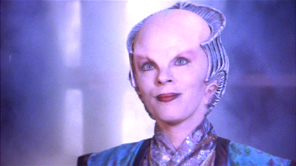
Babylon 5 is an American space opera television series created by writer and producer J. Michael Straczynski, under the Babylonian Productions label, in association with Straczynski's Synthetic Worlds Ltd. and Warner Bros. Domestic Television. After the successful airing of a test pilot movie on February 22, 1993, Babylon 5: The Gathering, in May 1993 Warner Bros. commissioned the series for production as part of its Prime Time Entertainment Network (PTEN). The show premiered in the US on January 26, 1994, and ran for five seasons.

Crusade is an American spin-off television series from J. Michael Straczynski's Babylon 5, released in 1999. Its plot is set in 2267, five years after the events of Babylon 5, and just after the movie A Call to Arms. The Drakh have released a nanovirus plague on Earth, which will destroy all life on Earth within five years if it is not stopped. The Victory class destroyer Excalibur has been sent out to look for anything that could help the search for a cure.

Susan Ivanova is a fictional character in the science fiction television series Babylon 5, played by Claudia Christian.
"Severed Dreams" is an episode from the third season of the science fiction television series Babylon 5. It won the 1997 Hugo Award for Best Dramatic Presentation.

John J. Sheridan is a lead character in the fictional universe of the science-fiction television series Babylon 5, played by Bruce Boxleitner. For most of the series, he is the commander of the Babylon 5 station; during the series' final season he is the President of the Interstellar Alliance.

Londo Mollari is a fictional character in the universe of the science fiction television series Babylon 5, played by Peter Jurasik.
The Starfury fighter is a fictional vessel used by Earthforce, the military branch of the Earth Alliance, in the science fiction television series Babylon 5. The computer-generated imagery (CGI) model was first seen in the opening episode of the first season, "Midnight On The Firing Line" which first aired in the United States in January 1994, and has essentially appeared in every episode thereafter.
A starbase is a facility, often in space, used in science fiction works such as Star Trek, Babylon 5, and Firefly. Typically they act as drydocks, battle stations or trading outposts.

Satai Delenn is a fictional lead character in the universe of the science fiction television series Babylon 5, played by Mira Furlan.

Jeffrey Sinclair is a character in the fictional universe of the science fiction television series Babylon 5, played by actor Michael O'Hare. He was a regular in the first season of the show, as Commander of the Babylon 5 station, and made a number of guest appearances afterward.

Babylon 5: The Gathering is the test pilot movie of the science fiction television series Babylon 5, aired on February 22, 1993. It is also the first of six feature-length films in the Babylon 5 media franchise.
As the Babylon station was conceived as a political and cultural meeting place, one of the show's many themes is the cultural and social interaction between civilizations. There are five dominant civilizations represented on Babylon 5: humans, the Narn, the Centauri, the Minbari and the Vorlons; and several dozen less powerful ones. A number of the less powerful races make up the League of Non-Aligned Worlds, which assembled as a result of the Dilgar War, which occurred 30 years before the start of the series.

Babylon 5: In the Beginning (1998) is a science fiction television movie set in the Babylon 5 fictional universe. It was written by J. Michael Straczynski and directed by Michael Vejar.

A Call To Arms (1999) is the fourth feature-length film set in the Babylon 5 universe. It was written by J. Michael Straczynski, directed by Mike Vejar, and originally aired on TNT on January 3, 1999.

Downbelow Station is a science fiction novel by American writer C. J. Cherryh, published in 1981 by DAW Books. It won the Hugo Award in 1982, was shortlisted for a Locus Award that same year, and was named by Locus magazine as one of the top 50 science fiction novels of all time in 1987.
The concepts of space stations and habitats are common in modern culture. While space stations have become reality, there are as yet no true space habitats. Writers, filmmakers, and other artists have produced vivid renditions of the idea of a space station or habitat, and these iterations can be categorized by some of the basic scientific concepts from which they are derived.
Babylon 5: A Call to Arms (ACtA) is a tabletop miniatures boardgame released in September 2004 by Mongoose Publishing, designed initially as an expansion to their Babylon 5: The Roleplaying Game, it is a complete game in its own right. Babylon 5: A Call to Arms is based upon the sci-fi television series Babylon 5 and draws heavily on material from the television show and the boardgame Babylon 5 Wars. The game's popularity exceeded Mongoose Publishing's initial expectations and has expanded to include new rules supplements and new miniatures; a second edition of the game was released in August 2007. Mongoose Publishing announced on their website in February 2008 that all production of miniatures for the line would cease as of March 2008. Mongoose have indicated they will continue to support the game however through supplements and articles in their in-house magazine Signs and Portents.











